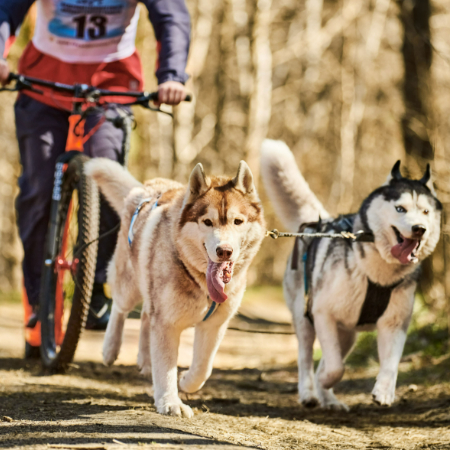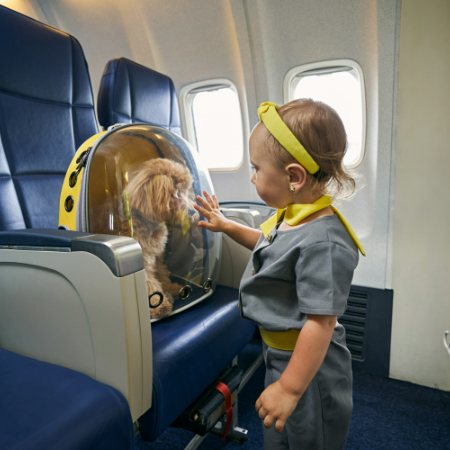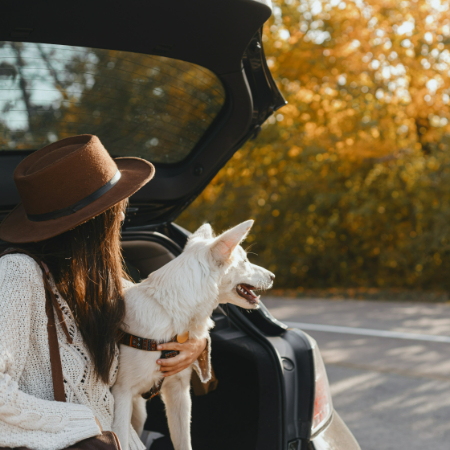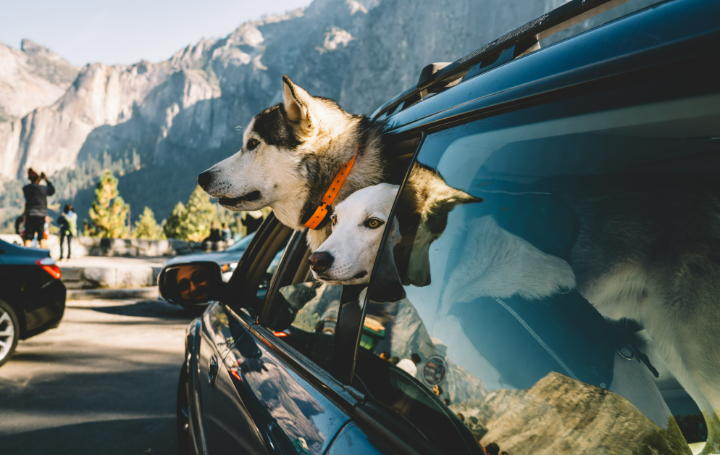How to Travel Safely with Your Dog: Tips for Road Trips, Flights, and More
A routine journey can become an amazing adventure when you travel with your dog. enjoying your pet along for a trip increases the thrill (and cuteness) factor exponentially, whether you’re traveling by car, enjoying a quick weekend trip, or traveling to a new place.
However, as every dog owner is aware, proper planning is necessary to guarantee a hassle-free and secure trip for the two of you. Here’s everything you need to know to travel safely with your dog, from packing the proper equipment to comprehending travel laws.
1. Preparing for the Journey
Make sure your dog is prepared for the journey both mentally and physically before you load up the car or schedule the flight. While some dogs enjoy jumping in the car and staring out the window, others may experience anxiety or car sickness. Flying is no different.
A. Vet Check-Up
A trip to the veterinarian should always come first while travelling with your dog. Make sure your puppy is well, has received all of his or her shots, and has no underlying medical issues that can complicate travel. A veterinarian’s health certificate could be required for foreign travel and must be presented to airlines or border control. If your dog is apprehensive, this is also an excellent opportunity to seek for advice on calming products or drugs for motion sickness.
B. Practice Runs
To help your dog become used to travelling, try taking them on shorter outings before bringing them on a lengthy car trip or flying. You can both acclimatise to the situation with a short drive around town or a stay at a nearby hotel that welcomes dogs. Consider it a prelude to the main journey—as well as a delightful justification for a little getaway.

2. Road Trip Ready: Safety First!
Road vacations are inherently exhilarating due to the open road, novel vistas, and flexibility to pause for an impromptu stroll or a bite at an eccentric wayside eatery. Although your dog may enjoy poking their head out the window, their security must come first.
A. Seatbelts & Crates
Dogs in moving vehicles must be securely restrained, just like people. Make sure your dog is restrained when driving, whether it’s in a crate, car seat, or pet seatbelt. A stray dog can easily be hurt in an emergency stop or, worse, cause you to become distracted and cause an accident. Car seats that raise smaller dogs to window level are an entertaining option that allows them to look out while remaining securely fastened up. Securing crates in the rear seat or trunk or using seatbelt harnesses are generally beneficial for larger dogs.
B. Frequent Breaks
Your dog may become uncomfortable on lengthy car drives, particularly if they aren’t accustomed to being in one spot for long. Schedule bathroom breaks, water breaks, and brief leg stretches every two to three hours. Look for parks or rest areas that allow pets so your dog may run about and relieve some energy. Bonus: you get to take in some fresh air as well!
C. Watch the Temperature
Even with the windows cracked, cars may heat up quickly in warm weather. In particular during the heat, never leave your dog unattended in the car. Even though it doesn’t look particularly warm outside, a car may get dangerously hot in a matter of minutes. Make sure your automobile has adequate ventilation, and always carry water to keep your dog hydrated.
3. Air Travel with Your Dog: Taking to the Skies
Although travelling by plane with your dog can be a little more difficult than travelling by car, it can go smoothly with sufficient planning.
A. Cabin vs. Cargo
Your dog may be permitted to travel in the cabin with you or will need to transit through the cargo hold, depending on the size of the dog and the airline. Generally, small dogs that fit in a carrier authorised by the airline are allowed to travel in the cabin beneath the seat in front of you. Cargo is frequently the only choice for bigger canines. To cut down on layovers and the amount of time your dog will spend in transit, try to schedule a direct trip if your dog must go via cargo.

B. Airline Policies & Preparation
Make sure to verify the policies of your airline in advance as each one has different rules about pet travel. Dogs are usually only allowed on a limited number of flights, so you’ll need to book a space in advance. Select an airline that welcomes pets and is reputable for treating animals well when making your reservation. To get detailed information about the treatment and storage of your dog, you can also give the airline a call.
C. Pet Carrier & Comfort
Purchasing a cosy pet carrier that has been approved by the airline is necessary for in-cabin travel. It should be just the right size to let your dog to lie down, stand, and turn around, but still tiny enough to fit beneath the seat. Allowing your dog to spend time inside the carrier at home with toys and treats will help them become accustomed to it in the weeks before your trip. Create a comfortable and encouraging environment for your dog to feel secure throughout travel day. Make sure the cage is strong, has good ventilation, and has soft bedding or blankets inside to keep your dog comfy when travelling in cargo.
4. Pack the Essentials
Packing more than just a toothbrush and a change of clothes is necessary when travelling with a dog. Make sure you have everything your dog might require for a pleasant and healthy travel experience.
A. Food & Water
Pack extra food in case of delays and plenty of your dog’s usual diet for the duration of the journey. Keep your dog’s nutrition consistent while travelling to avoid upsetting their tummy. A portable water bowl and a water source should not be overlooked. Keep yourself hydrated, especially on lengthy flights or vehicle trips.
B. Comfort Items
A few comforts from home, such your dog’s favourite blanket or toy, should be brought with you. In strange places, these objects can bring solace and a sense of home. Cosy blankets are also helpful for bringing cosiness to a cold flight or creating a homey atmosphere in a hotel room.
C. First Aid Kit
A modest pet first aid kit is a wonderful idea to have with you because you never know when a minor emergency might arise. Add necessary items like as bandages, antiseptic wipes, tweezers (for removing ticks), and any prescription drugs your dog takes on a daily basis. It will ease your mind to know that you are ready for any small bumps or mishaps.
5. Dog-Friendly Accommodations & Activities
Discovering new locations together is one of the greatest aspects of travelling with your dog. To include your dog in the enjoyment, when you are organising your trip, search for accommodations, activities, and hotels that allow dogs.
A. Dog-Friendly Hotels & Airbnbs
Although more and more hotels and vacation rentals are opening up to dogs, it’s still a good idea to check their restrictions in advance. Breed or size limits apply in certain locations, and there may be a pet fee in others. Seek lodging options that include pet-friendly features such as dog beds, snacks, or parks close by for strolls.
B. Outdoor Adventures
Look for dog-friendly activities when you’re travelling, whether it’s through national parks or a new city. Dogs are welcome on many beaches, parks, and hiking trails. Some of these locations even allow your dog to run free in off-leash areas. Just remember to pick up after your dog and abide by any leash rules in your area to make sure everyone can enjoy the area.
C. Dining Out
If you’re going to eat out, look for establishments that let dogs sit outside. Some restaurants even go so far as to provide water containers for dogs on the terrace or dog-friendly menus. Extra points if their staff members are dog lovers and will secretly feed your dog treats!
6. Handling Dog Anxiety While Traveling
Particularly if they’re not used to it, travelling can be upsetting for some dogs. There are a few things you can do to support your dog in remaining calm if they have trouble adjusting to new situations.
A. Calming Supplements & Aids
Talk to your vet about natural calming supplements, such as CBD treats or pheromone sprays, that can help ease travel anxiety. You can also bring along their favorite chew toy or a puzzle toy to keep them occupied and distract them from any stress.

B. Stick to a Routine
Dogs thrive on routine, so make every effort to maintain your normal resting, walking, and eating schedules. It can also make your dog feel more comfortable to have their favourite toy, blankets, and regular meals with them.
Final Thoughts: The Joy of Traveling with Your Dog
At the end of the day, traveling with your dog is all about making memories together. With a bit of planning, you can ensure your dog’s safety and comfort while still having a blast. Whether you’re cruising down the highway or flying to new destinations, your dog will love being part of the adventure and you’ll love having them by your side. Safe travels!
Doglime for more dog-related information.
Tags










